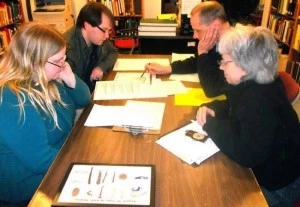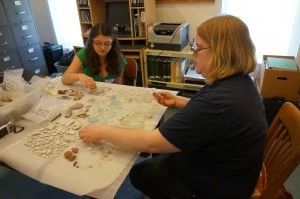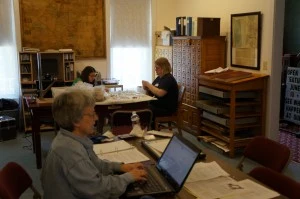The Excavation of Forgotten Fort Dayton - Archaeology in Central New York [VIDEO, PHOTOS]

When it comes to exploring history nothing is more 'hands on' than historical archaeology. Through hard work and shovel-fulls of of dirt through a screen a forgotten Fort has come back to life.
Archaeology is generally one of those degrees that makes you wonder what you were thinking, especially as an undergraduate degree. I did my fieldwork at a Revolutionary War era site, Fort Edward and focused on Geo-Archaeology but there's never really been a call to break out that knowledge. Unless you want to work state/federal or for a Contract Resource Management firm and take a 6 week excursion to who knows where for once a year and be done (out of a job after 6 weeks) archaeology outside of University just isn't a big demand. It's extensive back-breaking, sun-burning labor that takes hours to dig down a few centimeters.
After a program with the Herkimer County Historical Society in late 2013, Executive Director Sue Perkins and Caryl Hopson noted that I had a degree in archaeology and asked if I would be interested in helping them re-open the Fort Dayton excavation that had taken place in 2002. Fort Dayton, known as 'The Forgotten Fort,' was constructed in 1776 under the supervision of Colonel Elia Dayton as part of the defensive chain of forts through the Mohawk Valley as the western frontier. While no significant events occurred at the fort itself, it is best noted as the Fort that supplied the militia that General Herkimer led into battle to relieve Fort Stanwix and after Stanwix burned Fort Dayton was known as the western-most point of the frontier.
 Caryl Hopson/Herkimer Historical Soc.[/caption] A historical society volunteer, Fred Doyle, who had conducted extensive research on what was known as "The Forgotten Fort" and together with the historical society and archaeologist Doug Pippin had managed to put together a brief excavation to search for the forgotten Fort Dayton in 2002. Their excavation uncovered a number of artifacts including some pipe stems, glassware and ceramics. The artifacts seemed period and were worthy of further research but after Doyle passed in 2003, the Fort was forgotten again. When the Herkimer County Historical Society wanted to resume the excavation for Fort Dayton it was an easy answer.
Caryl Hopson/Herkimer Historical Soc.[/caption] A historical society volunteer, Fred Doyle, who had conducted extensive research on what was known as "The Forgotten Fort" and together with the historical society and archaeologist Doug Pippin had managed to put together a brief excavation to search for the forgotten Fort Dayton in 2002. Their excavation uncovered a number of artifacts including some pipe stems, glassware and ceramics. The artifacts seemed period and were worthy of further research but after Doyle passed in 2003, the Fort was forgotten again. When the Herkimer County Historical Society wanted to resume the excavation for Fort Dayton it was an easy answer.
 After meeting to review the previous excavation for Fort Dayton we decided that it would be best to expand the Shovel Test Pits (STP), archaeology speak for digging a small hole, into excavation pits at the sites were the majority of the artifacts had been recovered from previously.
After meeting to review the previous excavation for Fort Dayton we decided that it would be best to expand the Shovel Test Pits (STP), archaeology speak for digging a small hole, into excavation pits at the sites were the majority of the artifacts had been recovered from previously.
Working with Herkimer County Historical Society, we assembled an excavation program plan and held an interest meeting on May 17th. Much to our surprise we received more than 40 volunteers eager to help with the excavation of Fort Dayton. And on May 31st the archaeological excavation of Fort Dayton resumed.
Day 1
On the first day of the excavation volunteers helped mark-off the STPs, test pits, that we wanted to expand based on the previous results while additional volunteers worked to accession the results from the 2002 excavation inside. After a few hours the teams had managed to process a number records while the excavation teams began uncovering artifacts. 

Excavation teams managed to recover a number of ceramics including pipe stems that would allow the lab teams to provide a date to the sites and after using relative dating methods the accessioning team identified the majority of our pipe stems dated the site between 1720 and 1750. The most interesting find of the day was however, an interesting cornerstone. According the the results from the earlier excavation, they believed it to be a foundation stone or cornerstone of some form. It was clear that there was something else to the stone. This site would need to be expanded on the second day of the excavation.

Day 2
On the second day of the excavation we expanded the test pit to include 3 additional test pits in hopes of uncovering whatever this structure/stone was and providing some context. While the excavation teams uncovered more ceramics, glassware, and even intact pipe bowls the team working on the stone pits discovered something else. The discovery of the large well-cap and subsequent well, based on the size and design may in-fact indicate that it is the old Fort Dayton well. As our historian searched through the records she has just recently discovered that there is a mention of an old well in the deed to the Suiter building. The excavation is continuing onward to recover any further information on the well, property and hopefully we will be able to identify the structure and the time period to which it belongs.
